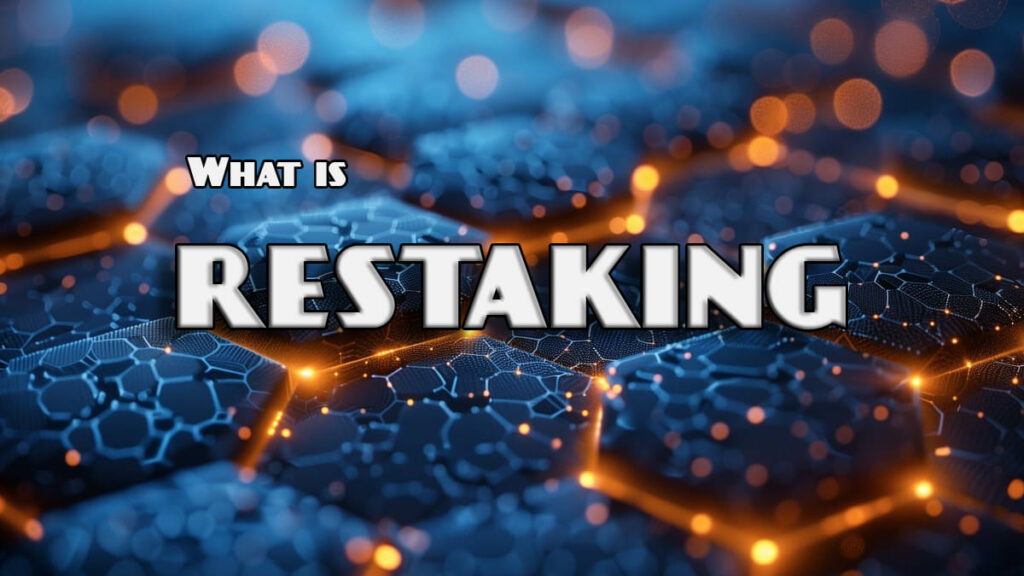The cryptocurrency market continues to surprise us with new ways to invest and maximize profits. New technologies and platforms are increasingly allowing investors to use their cryptocurrencies more efficiently.
One of the new investment methods revolutionizing Decentralized Finance (DeFi) is Restaking. This new way of depositing cryptocurrencies allows for greater profits while ensuring greater security on the blockchain. Let’s look at all the details:
What Is Restaking?
Restaking is a process in the world of cryptocurrencies and blockchain technology that involves restaking previously deposited assets, but this time on a different platform or program. When you stake your assets, you basically lock them to support the security and functionality of a blockchain network. Restaking takes this a step further by allowing you to deposit those same assets on another platform, increasing their utility and potential rewards.
For example, suppose you initially staked your assets on a Proof of Stake (PoS). With restaking, you can take those same assets and redeposit them on a different blockchain or platform that could offer new benefits. This process not only maximizes the potential of your crypto investment but also helps secure and support multiple blockchain networks.
How Does Restaking Work
Reviewing the concept of Restaking, this involves staking assets multiple times, usually on different platforms or protocols. This strategy aims to improve the utility of assets and maximize for the holder.
To make this a bit clearer, let’s look at an example: Imagine a validator, in addition to securing the Ethereum network and earning a 4% annual return, decides to use some of their Ether to secure a new blockchain network called Y, which offers an additional 5% return.
By doing this, the validator would be contributing to the security of network Y and, in return, would receive an additional 5% return on the amount of Ether they have committed. This adds to the 4% they are already earning with Ethereum, resulting in a total return of 9% for that specific portion of their funds.
Types Of Restaking
Restaking comes in two main types: native restaking and liquid restaking.
Native restaking involves the use of smart contracts to manage assets under a validator’s node, improving the security of the assets. Validators participating in native restaking programs must adopt specific additional node software for the restaking module, allowing them to securely offer their staked assets for later use within the restaking ecosystem. This procedure guarantees the security of assets while enabling validators to access extra reward possibilities.
On the other hand, liquid restaking uses Liquid Staking Tokens (LST). In this type of restaking, users deposit their assets in an application in exchange for an LP token (liquidity provider). The user can then place their LP token in another staking protocol. This approach provides users with more flexibility and liquidity compared to native restaking, as they can easily trade their LP tokens on the open market.
Where To Start Restaking?

Currently, there are several platforms that have established themselves as great options if you want to start in the world of restaking. Let’s look at some of them to get a general overview of how each one works:
- Kelp is a platform focused on increasing the availability of funds in the decentralized finance (DeFi) sector through restaking. Its goal is to achieve this by offering higher rewards for assets that are “restaken” within the EigenLayer ecosystem. Users can earn EigenLayer Points and Kelp Miles by restaking native Ethereum and ETH LSTs as collateral.
- EigenLayer: This platform is revolutionizing security through restaking, allowing ETH stakers to extend their assets beyond Ethereum. EigenLayer improves protocol security, flexibility for developers, and capital efficiency for stakers. Additionally, EigenLayer’s EigenDA project aims to reduce gas fees in Ethereum Layer 2 solutions.
- Etherfi: This protocol stands out for being a pioneer in liquid restaking. Built on the Ethereum blockchain, Etherfi uses the network’s Proof of Stake (PoS) infrastructure to enhance security across various protocols. Through partnerships with EigenLayer, Etherfi allows participants to contribute to the validation of software modules based on Ethereum, fostering a more decentralized and secure network.
Restaking Benefits
Restaking offers several key benefits:
- Flexibility: Allows traders to increase their flexibility by using deposited assets in various financial activities without the need to unlock them, providing access to liquidity while maintaining the potential for rewards.This adaptability results in a more effective allocation of funds and optimizes the use of assets that have been staked.
- Mitigates limitations of traditional staking: Addresses the opportunity cost associated with traditional staking, where assets are locked and inaccessible. It allows token holders to obtain liquidity from their assets without giving up potential rewards.
- Scalable security: Allows protocols to achieve a higher degree of security, depending on network demands. Thanks to restaking, protocols can increase their security when necessary by hiring validators present in a restaking protocol. Once security demands are met and the network returns to normal, protocols can reduce security.
- Benefits for new protocols: New protocols and networks need help developing a proper security system. This is especially true during the early stages of the protocol. Restaking gives these protocols access to a large set of validators at the beginning of their development, allowing them to significantly strengthen their legitimacy.
On the other hand, some risks associated with restaking include centralization of stakes and the possibility of reduction due to non-compliance with restaking conditions. These risks should be considered when participating in restaking programs.
Conclusion
Restaking is making waves among crypto investors. It cannot be ignored the enormous benefits it can generate for a user looking to optimize their investment.
Furthermore, restaking allows liquidity to be provided to several networks at the same time, enabling more projects to develop using this new modality.
It is very possible that this is just the beginning of restaking and we will see new developments in this growing industry.












